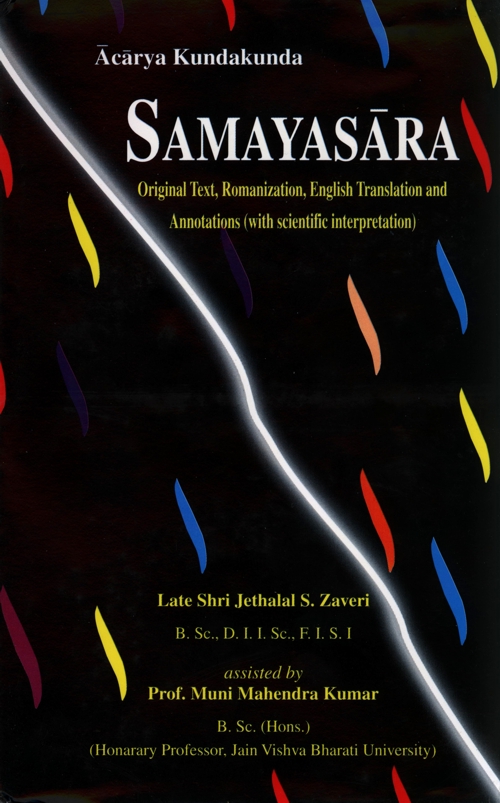
ṇavi hodi appamatto ṇa pamatto jāṇago du jo bhāvo.
evaṃ bhaṇaṃti suddhaṃ ṇādā jo so du so ceva.. 6
(Jo du jāṇago bhāvo) The attribute of consciousness (ṇavi hodi) is neither (appamatto) virtuous (ṇa) nor (pamatto) vicious (evaṃ) and so (bhaṇaṃti suddhaṃ) is said to be pure (ca) similarly (jo ṇādā) the Knower i.e., the subject of consciousness (so eva) is also pure (when it knows itself).
Annotations:
The formalities having been completed, Ācārya Kundakunda proceeds to deal with the subject proper, viz., the character of the self.
Few problems have more constantly attracted the attention of philosophers especially Jain philosophers than that of the relation between the Self and the non-self or the soul and the body; and perhaps no problem has given rise to graver misconceptions for want of correct insight into the true character of the Self.
Neither by the unphilosophic speculations of ordinary persons nor by the intensively philosophical theories of scholars, could the problem of the dualistic separtation of a living organism into a 'body' and a 'soul', be unambiguously determined. In our direct immediate experience a human being is neither a body nor a soul nor yet a composite of the two but simply an individual - possessor of the capability of knowing, experiencing and intercommunicating with other individuals. In actual worldly life the severance of the original unity of our experience into a physical and a psychical aspect is not only unnecessary but also unempirical. But transcendentally, the two aspects must be separated by ascertaining their respective characters.
For the process of severance, first thing is to fix a criterion by which the distinction between the self and non-self can be made. This criterion must be, besides being infallible, a characteristic belonging to the SELF and to nothing else. Thus the criterion must in the technical Language of logic, be the predicate of an exclusive proposition of which 'self is the subject. We must be able to say "only the self possesses the quality 'x'." Such a quality is 'Consciousness' or the faculty of knowledge. Knowledge by itself is neither virtuous nor vicious-it is a pure capability. And the application of the capability in the process of "knowing the self is also nothing but pure consciousness.

vavahāreṇuvadissadi ṇāṇissa carittadaṃsaṇaṃ ṇāṇaṃ,
ṇavi ṇāṇaṃ ṇa carittaṃ ṇa daṃsaṇaṃ jāṇago suddho.. 7
(Caritta-daṃsaṇaṃ ṇāṇaṃ) Trifurcation of (Consciousness) into (i) conduct, (ii) world-view and (iii) knowledge (ṇāṇissa) possessed by the cogniser (vavahāreṇa uvadissadi) is only an empirical conception [transcendentally] (ṇa vi ṇāṇaṃ) there is no knowledge (ṇa carittaṃ) no conduct (ṇa daṃsaṇaṃ) no world-view (jāṇago suddho) just pure consciousness.
Annotations:
This verse introduces the unique technique called 'Naya' conceived by the Jain Scholars for comprehending a very complex entity like soul (Jīva). When we are dealing with a complex entity which possesses innumerable attributes, some of which are empirical, i.e., useful in worldly life, while some others are purely transcendental and incapable of being apprehended by normal human faculties, it is impossible to grasp its nature in its entirety at once. 'Naya' is a technique of comprehending such a complex subject by studying only a part of it at a time without discarding the other parts; just like a branch of science that deals with some particular aspects of things, leaving others on one side. The various sciences are different not because they deal with different things or different sets of facts but because they look at these facts from different aspects or points of view. Thus physics and chemistry do not deal with different objects. Thus, physics is concerned with mass, density, temperature and such other aspects of physical objects. Chemistry studies how they are constituted e.g. two atoms of hydrogen combine with one atom of oxygen to produce a molecule of water and leaves the above aspects aside.
All techniques of apprechending the soul can be broadly brought under two groups: (i) vyavahāra and (ii) niścaya. Vyavahāra naya or empirical technique deals mainly with the attributes which are useful in actual worldly life and presents them so that they can be understood by common people. It usually leaves all ultimate questions aside. It is necessarily an analysic process breaking down complex features into simpler ones. Niścaya naya, on the other hand is concerned mainly with the ultimate problems of existence and presents the transcendental aspects of jīva. Its approcah is synthetic rather than analytic. Thus the fundamental characterstic of jīva is consciousness. Vyavahāra naya breaks down the attribute into three simper elements: conduct, world-view and knowledge. Ultimately, however all three are put together to make up a complex whole. The verse emphasizes that the break down of the whole into three elements is useful only in the worldly life (vyavahāra). An emancipated soul does not lose consciousness, because it is a characteristic which never leaves jīva but there is no necessity of the analytic process since the soul transcends the divisions.
 Jethalal S. Zaveri
Jethalal S. Zaveri
 Prof. Muni Mahendra Kumar
Prof. Muni Mahendra Kumar

